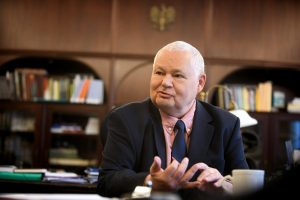Investing for the Long-term: Gold as a Pillar of NBP’s Reserve Management Strategy

Author: Professor Adam Glapiński
Central banking is typically associated with conducting monetary policy. But central banks have also other important roles, one of which is holding and managing foreign exchange reserves. Indeed, as stipulated in the Act on Narodowy Bank Polski – Poland’s central bank charter – the central bank holds and manages FX reserves as well as takes measures to ensure the safety of foreign exchange operations and Poland’s external payment liquidity. At the end of May 2021 official reserve assets of Narodowy Bank Polski (NBP) accounted for USD 162.7 billion, increasing in USD terms roughly six-fold from USD 27.5 billion in 2000 and almost doubling over the past decade.
In a monetary policy strategy based on a floating exchange rate regime – such as in Poland – the role of FX reserves is primarily to enhance the country’s financial credibility, thereby reducing the cost of financing in the global markets and the volatility of the złoty exchange rate, as well as to mitigate the risk of sudden capital outflows. Incidentally, FX reserves may also be used to support the stability of financial markets or the banking sector in the event of significant disturbances in their functioning.
Thus, as a public investor, NBP differs from a typical asset manager in that it holds a large investment portfolio, placing primary weight not on maximizing returns but on preserving liquidity and security of its endowment. The underlying idea is simple: if the FX reserves are not deployed to combat some financial stability or balance-of-payments emergency, they are to be preserved, preferably increased and passed on to another generation.
With such a strict investment mandate, it is perhaps no wonder that NBP considers gold as a special component of its official reserve assets. After all, the characteristics of gold are very well aligned with the precautionary role of maintaining foreign reserves and preserving capital in the long term, weathering periods of stress and varied market conditions.
Gold offers some unique investment features – it is devoid of credit risk, it is not easily “debased” by monetary or fiscal mismanagement of any country, and while its overall supply is scarce its physical features ensure durability and almost indestructibility. For all these reasons gold is considered as an ultimate strategic hedge.
The practical side of it all is that gold acts like a safe haven asset, in that its value usually grows in circumstances of increased risk of financial or political crises or turbulences. In other words, the price of gold tends to be high precisely at times when the central bank might need its ammunition most.
The recent COVID-19 crisis provides an excellent case in point. During the beginning of the pandemic when the high level of uncertainty and the ultra-low interest rate environment supported strong flight-to-quality flows – in the first half of 2020 gold price climbed by almost 17% in US-dollar terms, significantly outperforming all other major asset classes, especially US equities which had yet to recover after the more-than 30% decline.
This episode underscores a more fundamental desirable feature of gold which is its low correlation with major asset classes and reserve currencies. Such low correlation reinforces the benefits of diversification of the reserve portfolio by improving its risk-return profile. This is particularly relevant in the case of NBP since – in line with the global tendencies – the US dollar continues to play a dominant role in our foreign reserves portfolio (51%). And since the correlation between gold and USD – both expressed in PLN terms – is low and in fact decreasing, gold can be seen as a natural hedge for our “long USD” position.

Warsaw, Poland: NBP Headquarters
Taking into account the successive growth of official reserve assets and the features of gold as a reserve asset, in 2018 Narodowy Bank Polski made a strategic decision to significantly expand its gold reserves. The decision was supported by the fact that NBP’s gold holdings were lower than implied by the overall size of its reserves portfolio when benchmarked against other countries.
As a result of purchases of 125.7 tons of gold conducted in 2018-2019, the gold stock of the NBP has increased to 228.7 tons. In the ranking of the size of the gold stock, Poland has moved from 34th to 22nd position among central banks in the world and from 15th to 11th in Europe, ahead of all countries in the region.
At the end of December 2020, the share of gold in NBP’s official reserve assets was 9%, compared to the average share of gold in foreign reserves of central banks in the world reaching 13%, and 25% in Europe. However, it is worth pointing out that some of the central banks with the highest share of gold in foreign reserves, like Federal Reserve, are issuers of world reserve currencies which results in the fact that they do not hold large official reserve assets, which somewhat artificially inflates the share of gold in their reserves. Therefore, gold holdings can be also analysed in the context of the total balance sheet of a central bank. In this alternative approach, the NBP’s share of gold is comparable to the shares recorded for Germany and the United States.
Following the decision of increasing gold reserves, in 2019 the Board of Narodowy Bank Polski decided to diversify gold storage locations by relocation of 100 tons of gold from the Bank of England to the domestic vaults. Diversification of gold storage locations is a frequent practice observed among central banks, aimed at reducing geopolitical risk, which could result in the loss of physical access to gold or a significant limitation of its free disposal.
Since the completion of the transport of gold to Poland in November 2019, almost 124 tons of gold have been left in the Bank of England’s vaults. Due to the strategic character of gold, it is generally not perceived as a source of income for central banks. However, the storage of gold in London creates for NBP an opportunity to increase the profitability of the official reserves by placing gold deposits on the interbank market.
Although considerable, the recent gold purchases were not NBP’s last word on the matter. In fact, the foreign exchange reserves management strategy adopted by the Board of Narodowy Bank Polski in 2020 assumes a further increase in the size of gold reserves, the scale and pace of which will depend on the official reserve assets dynamics and market conditions.
Perhaps Shakespeare was right and generally in life “all that glitters is not gold… gilded tombs do worms enfold”. But, while managing NBP’s foreign exchange reserves, we have a somewhat narrower philosophical focus and certainly don’t mind some glitter in our portfolio.
About the Author
Professor Adam Glapiński, Professor of Economics, lecturer at Polish and foreign institutions of higher learning. Since the 1990s, he has held numerous important posts in public administration. He chaired supervisory boards of various companies. He has been with NBP for many years, as a member of the Monetary Policy Council and the NBP Management Board. Member of the International Joseph A. Schumpeter Society.
You may have an interest in also reading…
Dr Rak Vorrakitpokatorn: Taking the Steps to Sustainability
Until fairly recently, the global community strived for economic gains while ignoring environmental, social and community impacts. Extreme climate change
Joseph R Waryoba, CEO of Exim Credit United Arab Emirates – Simplicity, Professionalism and Passion Make a Trinity for Trust — and Trade
Joseph R Waryoba, CEO of Exim Credit United Arab Emirates, has an abiding professional philosophy: keep it simple. “Life is
MegaInver: Tailored to Meet Market Demand
MegaInver is a leading independent asset management company in Argentina. The firm began its operations in 2012 and is led


















































































